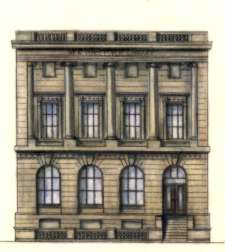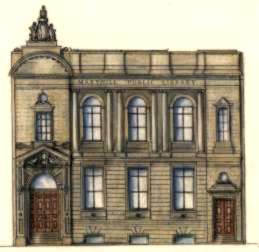

American Carnegie Libraries
Although Andrew Carnegie began his worldwide library donations in Scotland, two-thirds of all Carnegie libraries were built in his adopted homeland, the United States, where there are nearly 1700.
There are many parallels as well as differences in the libraries on either side of the Atlantic. I'll begin with a comparison of the libraries in the Carnegie family's ports of departure from Scotland and arrival in America - Glasgow and New York City.


Riverside Library, New York City and Maryhill Library, Glasgow
In both Scotland and the United States, the style of architecture for libraries in the big cities was different from the rural areas.
Some of Glasgow’s neo-classical libraries were similar to those erected in New York City, where Carnegie had funded their libraries two months earlier with his largest ever grant of $5,200,000.
At the turn of the century, the cities of Glasgow and New York were both highly plotted with multi-storey buildings in neighbourhoods with constantly growing populations. The libraries built in Glasgow and Manhattan were mostly built in areas of high-density tenement housing where the libraries had to fit in to the existing developments.
Unlike in Glasgow, where the designs were selected in open competition, three of New York's most prestigious architectural firms were asked to draw up the design guidelines for the Manhattan libraries, which were all to be in the "Classical Revival" style.
Carrère and Hastings were responsible for the largest number of branches in New York City, designing 14 of them, including Riverside Library. Their functional classical designs produced attractive libraries to which Maryhill Library is Glasgow's closest comparison.
Riverside Library was opened on 16th February 1905 and survived until 1965, when it shared the fate of many of the other Manhattan libraries occupying very valuable sites - demolition for redevelopment.
The library at Dublin, Georgia is a splendid example of the classical style of architecture adopted for many of the libraries in small town USA. For economic reasons these libraries could not be as grand as those in the big cities.
Airdrie Library, one of Scotland's earliest, dating from 1893, is the nearest Scottish comparison to the American style .
The library at Adrian, Michigan illustrates how some American architects sought to move away from the rigidity of classical conformity to more relaxed informal style. The example had been set by Henry Hobson Richardson in the mid 1800's, who had shown the designers following him that public buildings need not be built in the classical manner.
The library at Stirling in Scotland is a fine piece of Scots Baronial architecture, which was popular for country houses including Carnegie's own mansion at Skibo in the Highlands.
The early 20th century modernism of architects such as Charles Rennie Mackintosh in Scotland and Frank Lloyd Wright in the United States, had little influence on the conservative tastes of Carnegie's principal advisors, James Bertram in America or Hew Morrison in Scotland.
The architectural variety of the Carnegie libraries, built in such a short period in both countries, is nevertheless still staggering.
If you wish to see how the commercial architecture of Glasgow compares with that in North American cities you should visit my Victorian Glasgow web page. This page illustrates Glasgow's early cast iron and glass structures and examines how the design of the city's office blocks compares with those in the United States where many of the new architectural ideas and construction methods originated.

The standard low budget rectangular buildings were however augmented with classical features such as pediments and columns, which mark them out clearly as Carnegie libraries, which are familiar landmarks throughout America.
The library illustrated is now occupied by the Laurens County Historical Society who kindly provided the information about their building.

It is a simple rectangular building built in red sandstone. The symmetrical neo-classical front features a rusticated ground floor. As with the Georgia library, the façade is enlivened with a central pediment supported by Ionic columns.
This library proved to be too small for Airdrie's needs and was replaced by a new library funded by the Carnegie UK Trust in 1925. In another parallel with its Georgia counterpart, it is now occupied as an Arts Centre.

This Romanesque library with its towers and banded stonework is a bold departure from the common style; it currently houses the Lenawee Historical museum.

Many Scottish architects, like their American cousins, were moving away from classical influences towards more freedom in style. The Stirling library, like the one in Michigan, doesn't follow any strict rules of symmetry or scale. It is a cleverly balanced design with many intricate details.
The library is still the central library for Stirling Council.
Carnegie Libraries of Scotland: Architecture & History

 Introduction
Introduction
The Carnegie Libraries
 Andrew Carnegie
Andrew Carnegie
His Scottish connections
 Early Carnegie Libraries
Early Carnegie Libraries
The first in the world
 American Libraries
American Libraries
A comparative study
 Scottish Architecture
Scottish Architecture
Unique libraries
 Renaissance
Renaissance
Edwardian architecture
 Baroque
Baroque
J.R. Rhind in Glasgow
 Library Architecture
Library Architecture
Diverse designs
 Inside the Libraries
Inside the Libraries
Photographs from 1907
 Carnegie Hero
Carnegie Hero
John Blaikie in 1911
 Exhibition
Exhibition
Landmarks of Literacy